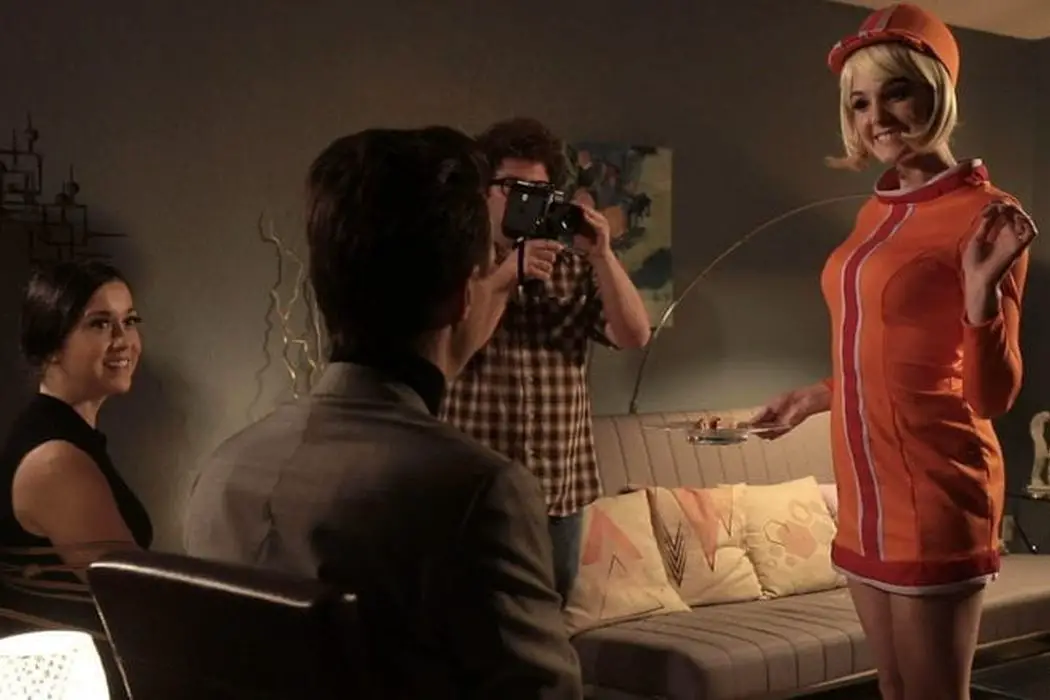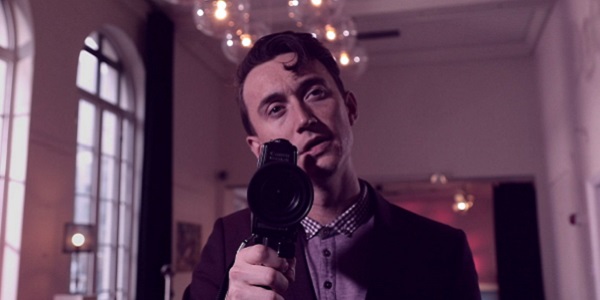WIVES OF THE SKIES: More Than Just A Sexy Uniform

Lee Jutton has directed short films starring a killer toaster,…
When an acquaintance sent actor and filmmaker Honey Lauren a link to vintage stewardess uniforms on eBay, she was surprised at the popularity and high prices of such items — and, that the people bidding on them were, for the most part, men. Following this discovery, Lauren was inspired to further explore the archetype of the “sexy stewardess” and the men who essentially created her to market their airlines. The resulting short film, romantic dramedy Wives of the Skies, follows a British journalist in 1965 who seeks to make a documentary film about two stewardesses. However, he quickly learns that beneath the figure-hugging uniforms, these women are far more than just objects for the male gaze to linger upon at 38,000 feet.
Service with a Smile
Derrick (Drew Brandon Jones) is a British journalist who decides to end a trip abroad in the United States by interviewing two stewardesses for the airline Fine Air. Fran (Rachel Alig) and Marcy (Maddison Bullock) are staying at the same hotel as Derrick between flight assignments and, true to the eager-to-please nature ascribed to their profession, are more than happy to acquiesce to Derrick’s request for an interview. Yet it’s clear from Derrick’s roving, hand-held camera — the audience often sees the women directly through his lens — that his interest in the women is less about their inner lives and more about their outer appearances, his gaze zooming in and roaming slowly over the long legs and tight curves hugged by their short, stretchy uniforms.

This aesthetic, undeniably designed to cater to the male gaze, combined with their airy voices and sweet, servile demeanor, makes Fran and Marcy seem, at first, like the ultimate male fantasy. But when Derrick is invited up to their hotel room for dinner, he is surprised to learn that these women have hidden depths and desires he never would have imagined — and, that they express these desires through the Japanese art of rope binding known as Kinbaku. That’s right, the stewardesses are into bondage, and Derrick’s mind is blown. Are the women doing this for his benefit, fully aware that they are titillating him? The truth is far more complicated than that and explores issues of security and trust in a way that Derrick could have scarcely imagined.
Fit to be Tied
Wives of the Skies goes all-in on its vintage aesthetic, even going so far as to list a copyright date of 1965 in the opening credits. The stewardess costumes, designed by Stephanie Scull, are picture-perfect for the period depicted, from the bright orange and pink color scheme to the impossibly short skirt length to the jaunty hats perched upon Fran and Marcy’s heads. While some aspects of the production design feel a little cartoonish — the retro wigs are a little too glossy — one otherwise easily feels as though one is watching a documentary short circa the mid-twentieth century while watching Wives of the Skies. (Alas, the objectification of women displayed by Derrick in this film could just as easily be from the year 2020.)
The casting is spot-on, from Jones as the smarmy, oh-so-stereotypically British journalist to Alig and Bullock as the stewardesses who shock and awe him. Lauren, who as an actor is best known for a wide range of cult films, is a capable filmmaker with a lot to say about the male gaze and the way society caters to it, selling sex without thinking about the complex inner lives of the women who are being sold as this sensual ideal. By frequently going behind Derrick’s Super 8 camera to show us exactly what he’s filming, Lauren forces the audience into complicity with his gaze. It’s an uncomfortable feeling and one that will leave you contemplating Wives of the Skies far beyond it’s 21-minute running time.
Conclusion
Wives of the Skies was earning raves on the festival circuit before the COVID-19 crisis led so many events to be abandoned for the sake of our health. If you have a chance to check it out, either in person or in the comfort of your home, it’s a worthwhile watch that says more about the socio-cultural impact of gender stereotypes than many features that try to do the same.
Does content like this matter to you?
Become a Member and support film journalism. Unlock access to all of Film Inquiry`s great articles. Join a community of like-minded readers who are passionate about cinema - get access to our private members Network, give back to independent filmmakers, and more.
Lee Jutton has directed short films starring a killer toaster, a killer Christmas tree, and a not-killer leopard. Her writing has appeared in publications such as Film School Rejects, Bitch: A Feminist Response to Pop Culture, Bitch Flicks, TV Fanatic, and Just Press Play. When not watching, making, or writing about films, she can usually be found on Twitter obsessing over soccer, BTS, and her cat.













